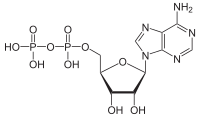
Photo from wikipedia
Introduction: Heparin-induced thrombocytopenia (HIT) is a complication of heparin therapy that is caused by antibodies to complexes of platelet factor 4 (PF4) and heparin. Several studies have reported that in… Click to show full abstract
Introduction: Heparin-induced thrombocytopenia (HIT) is a complication of heparin therapy that is caused by antibodies to complexes of platelet factor 4 (PF4) and heparin. Several studies have reported that in order for these immune complexes to be pathogenic, they must assemble on the platelet surface. When bound to the platelet surface, the conformation of PF4 allows for optimal presentation of the epitope for antibody binding and subsequent activation of Fc-receptors on platelets and monocytes. To what degree pathogenic HIT immune complexes can form and activate platelets in fluid-phase as with other immune complex diseases (systemic lupus erythematosus, glomerulonephritis, and rheumatoid arthritis) is not known. We used mutated PF4 proteins that can no longer bind the platelet surface to evaluate anti-PF4/heparin antibody induced platelet activation. We hypothesized that the epitopes required for PF4 binding of HIT antibodies and subsequent platelet activation can be formed in fluid-phase. Methods: Each of the 70 amino acids of PF4 were mutated previously by alanine scanning mutagenesis where non-alanine residues were mutated to alanine or alanine residues to valine. We selected 14 PF4 mutants that affected KKO (a platelet-activating murine monoclonal HIT-like antibody) binding in a heparin-capture assay for this study. Mutant and wild-type PF4 were overexpressed in Escherichia coli and affinity purified. To confirm binding to platelets, biotin-conjugated PF4 mutants were incubated with donor platelets and PF4 platelet binding was measured using streptavidin-FITC by flow cytometry. Platelet activation was measured using a modified 14C-serotonin-release assay, where excess wild-type or mutant PF4 (0, 50 and 100 μg/mL) was added to 14C-serotonin-labelled donor platelets and activation was measured after incubation with KKO. ≥20% 14C-serotonin release was considered positive for platelet activation. Platelet activation was correlated with platelet surface binding to identify mutants that could form surface-bound or fluid-phase antigenic complexes. Results: Of the 14 PF4 mutants tested, 7 bound to platelet surfaces and 11 supported platelet activation by KKO. These PF4 mutants were further characterized into 3 categories: PF4 mutants that bound to the platelet surface and induced platelet activation (n=6); PF4 mutants that did not bind to the platelet surface but induced platelet activation (n=5); and PF4 mutants that bound to the platelet surface but did not induce platelet activation (n=1). These results indicate that certain PF4 mutants were able to bind KKO and induce platelet activation in fluid-phase. These data suggest that specific epitopes in fluid-phase PF4/heparin immune complexes can mediate platelet activation in HIT, without the need for surface assembly on the platelet. Conclusions: Using point mutations of PF4, we have identified that the HIT antigenic complexes can be formed in fluid-phase and induce platelet activation. Further studies are required to investigate the role of a fluid-phase HIT antigen complex in the development of thrombocytopenia, inflammation and thrombosis of HIT. This study was funded by the Canadian Institutes for Health Research. Arnold: Bristol Myers Squibb: Research Funding; Amgen: Consultancy, Research Funding; UCB: Consultancy; UCB: Consultancy; Novartis: Consultancy, Research Funding; Novartis: Consultancy, Research Funding; Amgen: Consultancy, Research Funding; Bristol Myers Squibb: Research Funding.
Journal Title: Blood
Year Published: 2018
Link to full text (if available)
Share on Social Media: Sign Up to like & get
recommendations!